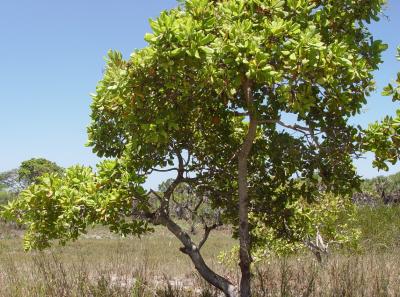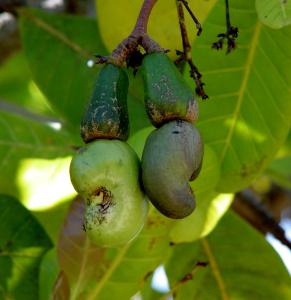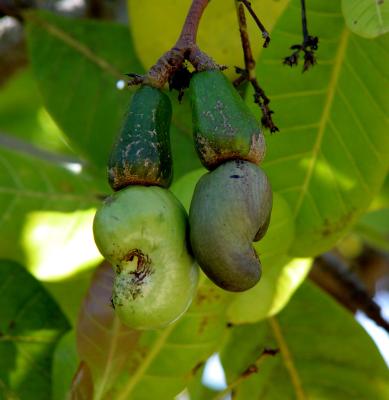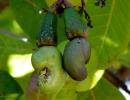
|
Cashew
Scientific name:
Anacardium occidentale
Order/Family:
Sapindales: Anacardiaceae
Local names:
Mkorosho / mkanju (Swahili)
Pests and Diseases:
Anthracnose
Cashew stem girdler
Cashew weevil
Coconut bug
Helopeltis bugs
Mealybugs
Powdery mildew
Thrips
Aphids
|
Anthracnose (Colletotrichum gloeosporioides)
The disease attacks young plant tissues and can cause severe crop loss when it infects flowers, which turn black and die. Young leaves, cashew apples and nuts are similarly affected. Infected young terminal shoots die back. The disease is promoted by warm, damp conditions.
- Prune dead branches and twigs and remove from the field. They constitute the principal source of infection.
- Though pesticide application on cashews is not practised in East Africa, copper based fungicides are known to be effective against anthracnose.
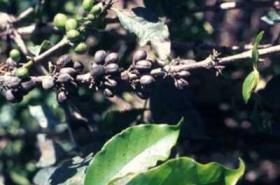
© Jürgen Kranz. Courtesy of Ecoport (www.ecoport.org).

Anthracnos…

Anthracnos…
Cashew stem girdler (Paranaleptes reticulata)
Adults are a long horn beetles, with a body length of 25-35 mm and with antennae longer that the body. The head and the thorax are dark brown; the wing cases are orange with large black blotches giving them a reticulate appearance. Adult beetles girdle branches from 3-8 mm in diameter leaving a V-section cut; only a narrow, central pillar round the pith zone is left, which eventually breaks off. Female beetles lay elongated eggs in transverse slits made in the bark of the girdled branch at points above the girdle. Larvae are yellow, in colour and reaches a length of 45 mm when fully grown. They mine in dead wood of the girdled branches. Pupation takes place in the dead wood. The lifecycle takes one year. This beetle is a common but usually minor pest of cashew in the Coast Province of Kenya. However, neglected plantations may be severely damaged. It is also present in Tanzania.
- Once a year (in November or December) collect and burn all girdled branches should be collected and burned. Only the dead or dying part of the branch above the girdle needs to be collected.
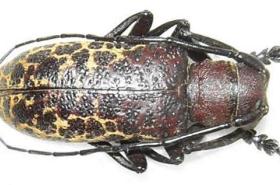
© www.cerambycoidea.com
The cashew weevil (Mecocorynus loripes)
The cashew weevil is large weevil, about 20 mm long, and of a knobbed appearance. It is dark grey-brown in colour. The female weevil lays single eggs in small holes in the bark of the trunk or branches. The larvae are legless grubs, whitish in colour with a brown head. They bore through the bark and move downwards tunnelling under the bark while feeding on the sapwood.
Brown-black gummy frass is seen on the trunk and main branches. Heavily attacked trees become ringed by damaged sapwood and eventually die. Neglected plantations are likely to be severely attacked. Fully-grown larvae pupate in a chamber about 2 cm below the bark.
- Cut away bark from damaged areas of lightly infested trees and kill the larvae and pupae underneath. Repeat this every month for a further six months if required.
- Destroy severely infested trees. First collect and destroy all adult weevils; then fell the tree and remove the bark to expose all larval galleries; kill all larvae and pupa and burn the tree.
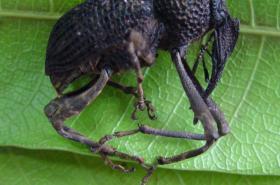
© A. M. Varela, icipe
Coconut bug (Pseudotheraptus wayi)
Adult bugs are reddish brown in colour and 12 to 14 mm long. Nymphs are red brown to green brown in colour and have long antennae. Bug feeding causes necrotic bruise-like depressions; a hard lump develops, which can be easily removed when the fruit is peeled. The bug sucks on the developing fruits causing pockmarks. The kernels are also affected showing spots, which lower their market value.
- Conserve natural enemies. Weaver ants nest on cashew trees deterring and feeding on coconut bugs.

© A.M.Varela, icipe

Coconut bu…

Weaver ant…
Helopeltis bugs (Helopeltis schoutedeni and H. anacardii)
Helopeltis bugs, also known as mosquito bugs or mirid bugs, are the most important pests of cashew. These bugs are slender, delicate insects, about 7- 10 mm long with long legs and antennae, the antenna being nearly twice as long as the body. The females are red and the males brown to yellowish red. They lay eggs inserted into the soft tissue near the tips of flowering or vegetative shoots. Nymphs (immature bugs) are yellowish in colour. Both adults and nymphs feed on young leaves, young vegetative and flowering shoots, and developing fruits.
Attacked leaves are deformed and show angular lesions, particularly along the veins, which may drop off, so that the leaves appear as if attacked by biting insects. Feeding on the stalks of the tender shoots causes elongated green lesions, sometimes accompanied by exudation of gum. Severely damaged shoots die back due to the effect of bug saliva in combination with fungi, which enter the plant tissue through the feeding lesions; the subsequent development of numerous auxiliary buds causes a bunched terminal growth known as 'witches broom'. In case of serious infestations the trees may appear as if scorched by fire. Bug feeding on developing apples and nuts causes brown sunken spots. The growth of trees is seriously retarded and fruit formation of attacking flowering shoots is reduced.
- Monitor the crop regularly. Helopeltis attack occurs very suddenly and great vigilance is very important to control this pest, particularly during the rainy season or when water is available leading to flushing (production of young shoots) when Helopeltis populations normally build up.
- Conserve natural enemies. Weaver ants build nests on cashew trees providing good protection against this and other bug pests.
- Do not interplant cashew with crops that are host for Helopeltis bugs, such as cotton, tea, sweet potato, guava and mango.
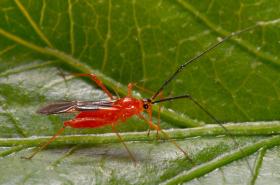
© F. Haas, icipe

Helopeltis…

Helopeltis…

Helopeltis…

Helopeltis…
Mealybugs (Pseudococcus longispinus)
The long-tailed mealybug (Pseudococcus longispinus) attacks shoots, inflorescences, apples and nuts. Affected parts appear completely white. Trees infested during the flowering stage fail to produce fruits, whereas those infested at the nut swelling stage produce discoloured nuts, which result in a lower grade. However, cutting tests showed no difference in kernel outturn between clean and discoloured nuts. Mealybugs have been a problem for cashew growers in Tanzania.
The body of the adult female is 2 - 3.6 mm long, soft, elongate oval and somewhat flattened.
- Conserve natural enemies. Mealybugs are usually controlled by a wide range of natural enemies. However, use of pesticides may kill these natural enemies leading to mealybug outbreaks.
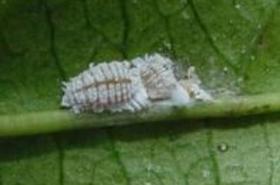
© A.M. Varela, icipe
Powdery mildew (Oidium anacardii)
This disease is particularly serious in coastal areas south of Dar es Salaam in Tanzania. Infected panicles and leaves are coated with white, powdery fungal growth. In severe attacks the entire panicle may be infected and the fruit and nuts fail to set.
- Pesticide application is not practised in cashew fields. However, sprays of powdered kelp, potassium / sodium bicarbonate and sulphur provide good control of powdery mildew.
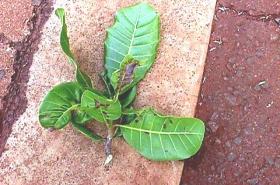
© A.A.Seif, icipe
Red-bandet thrips (Selenothrips rubrocinctus)
Adults of the red banded thrips are dark brown or blackish. Nymphs are pale yellow with a broad transverse red band on the dorsal side of the abdomen. Thrips attack older leaves, flowers and shoots. Attacked leaves drop off leaving bare shoots with few young leaves at the tip. Infestation of flowers causes poor fruit formation. Locally limited infestations may cause considerable damage.
- Conserve natural enemies. Anthocorid bugs are important in natural control of thrips.
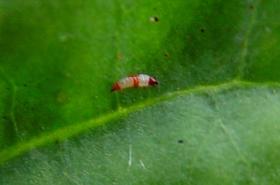
© A. M. Varela, icipe
| General Information and Agronomic Aspects | Information on Diseases | |||
| Information on Pests | Information Source Links |
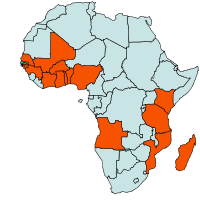 |
| Geographical Distribution of Cashew in Africa |
Cashew trees are grown along the coastal plains of Kenya and Tanzania. Cashews are evergreen trees with deep taproots, originating from the northern part of South America. The Portuguese introduced cashew to Mozambique in the 16th century where it flourished forming extensive forests; eventually it also became dispersed in East Africa. Cashew is grown along the coastal plains of Kenya and Tanzania
The liquid of the shell is used for brake linings, heat proof and waterproof paints and protective varnishes. Cashew nut wood is of poor quality but can be used as firewood if mixed with other types of wood.
|
|
| Raw or Cooked Vegetable | Food Energy (Calories / %Daily Value*) |
Carbohydrates (g / %DV) |
Fat (g / %DV) |
Protein (g / %DV) |
Calcium (g / %DV) |
Phosphorus (mg / %DV) |
Iron (mg / %DV) |
Potassium (mg / %DV) |
Vitamin A (I.U) |
Vitamin C (I.U) |
Vitamin B 6 (I.U) |
Vitamin B 12 (I.U) |
Thiamine (mg / %DV) |
Riboflavin (mg / %DV) |
Ash (g / %DV) |
| Cashew nuts raw | 553 / 28% | 32.7 / 11% | 43.8 / 67% | 18.2 / 36% | 37.0 / 4% | 593 / 59% | 6.7 / 37% | 660 / 19% | 0.0 IU / 0% | 0.5 / 1% | 0.4 / 21% | 0.0 / 0% | 0.4 / 28% | 0.1 / 3% | 2.5 |
- Place the seeds in a bucket of sea water (100g salt per 5 litres of water) and select the seeds that sink for planting. Those that float have poor germination and growth potential.
- Sun dry seeds for planting for several weeks to prevent mould and rotting.
- Do not plant seeds that are more than one year old
- Good, selected seed may be purchased from the KARI - Mtwapa Research Centre, Kenya
Recommended spacing in good rainfall areas is 12mx 6m, giving 139 trees per ha. In low rainfall areas spacing of 12mx12 m (69 trees/ha) is recommended to give the trees a better chance for survival.
Only the healthiest trees are worthwhile keeping for long growing periods.
Planting methods include:
- Direct planting of seeds: This method has the advantage that less labour is needed but there is higher risk of death during dry season and also a higher risk of early diseases. Plant 3 seeds per hole covered by 6-8 cm of soil
- Raising seedlings in polybags in the nursery: This method has the advantages that it is easier to water the seedlings properly, which is particularly important in the dry season, and that is possible to select the strongest and healthiest plants for transplanting. Disadvantages are that more labour is required and it is a bit more expensive. Seedlings in polybags should be transplanted 6 weeks after sowing in order to avoid damage to the taproot
Thin after 3-4 months leaving only the strongest plant at each site. Protect seedlings from monkeys, rodents and bucks by placing wire cages or thorns around the seedlings. Support plants with a stick and trim off side shoots up to 60-90 cm from ground level. When trees are mature, prune dead wood or any borer damaged or intergrowing branchesto give the canopy air and light.
- FAQ (Fair Average Quality) - normally about 75%. These are healthy nuts with pinkish to greyish colour with no shrinkage or distortion.
- UG (Under Grade) - normally about 25%. Nuts which may have some blackish colour, distortion or shrinkage but not rotten.
Sun dried raw nuts for one to six days to reduce moisture content to 9% or less for safe storage and to mature the seed through the infra red and violet rays of the sun. Correctly dried nuts are pinkish in colour and produce a rattling sound when shaken. No mark can be made on a dry nut with a thumbnail. Dry raw nuts can be stored under dry conditions for at least two years without losing their flavour, but they are generally processed within one year of harvesting.
The decortication of cashew nuts is hampered by the liquid contained in the cashew nut shell. This liquid is a viscous, oily liquid, pale yellow to dark brown in colour with a bitter taste and caustic properties; it causes blisters on human skin unless precautions are taken, and it will spoil kernels on contact. In traditional artisanal cashew processing the nuts are put in an open pan over an open fire and stirred continuously to avoid scorching until they start burning, then they are thrown on sand to extinguish the fire and to remove the remaining humidity on the outer skin.
In industrial processing the nuts are graded in different size classes and rehumidified at about 16% moisture by spreading water over them for about two days to make the kernel elastic and to fill the cells of the shell with water. Then, they are roasted in a hot oil bath heated to 192°C for about 90 seconds depending on the size of the nuts. Through the roasting process, the cells of the shell break and about 25 % of the shell liquid flows into the bath. The remaining liquid on the outer shell is removed with sawdust.
Both the artisanal and the industrial methods make the shell brittle so that they can be broken easily.
Another method to avoid contamination of the kernel with the shell liquid is to deep-freeze the nuts and split the shells while frozen.
There are different methods for manual cashew shelling. The simplest consist of placing the prepared nuts on a stone using a hardwood stick to crack the shell. A semi-mechanised process uses a pair of knives shaped in the contour of half a nut. The knife system is also used in industrial plants. In another industrial processing method centrifuges are used to crack the shells; shells and kernels are then separated in an air stream, heated shells are lighter and blow away.
After shelling the kernels have to be dried to about 6% moisture content, thereafter the testa can be peeled off easily. Kernels are then graded, rehumidified to 8% and packed in airtight containers filled with carbon dioxide (CO2) and sealed. The CO2 inhibits infestation by insects and is slowly absorbed by the nuts thus producing a vacuum that prevents shaking and breaking of the nuts during transportation.
Cashew apple processing:
Apples are steamed under pressure or cooked in a 2% salt solution to remove the astringency. Addition of gelatine, pectin or lime juice clears the cashew juice from remaining undesirable contents.
- Acland, J. D. (1980). East African Crops: An Introduction to the Production of Field and Plantation Crops in Kenya, Tanzania and Uganda. FAO. Longman Group Limited London. ISBN: 0 582 60301 3
- Agricultural Information Center (AIC) (2002). Field Crops Technical Handbook.Min of Agriculture, Nairobi, Kenya .
- Behrens, R. (1996). Cashew as an Agroforestry Crop- Prospects and Potentials. Tropical Agriculture. GTZ. Margraf Verlag. ISBN; 3-8236-1257-3.
- Bohlen, E. (1973). Crop Pests in Tanzania and their Control. Federal Agency for Economic Cooperation (bfe). Verlag Paul Parey. ISBN: 3-489-64826-9.
- Griesbach, J (1992). A Guide to Propagation and Cultivation of Fruit Trees in Kenya. Schriftenreihe No. 230, Eschborn, Germany: GTZ. ISBN 3-88085-482-3
- Hill, D. (1983). Agricultural insect pests of the tropics and their control. 2nd edition. Cambridge University Press. ISBN: 0-521-24638-5.
- Integration of Tree Crops into Farming Systems Project (GTZ) and Ministry of Agriculture and Rural Development, Nairobi, Kenya (2000). Tree Crop Propagation and Management - A Farmer Trainer Training Manual.
- Ministry of Agriculture, Livestock Development and Cooperatives. Tanzania. Annual reports. Plant Protection Division.
- Nutrition Data www.nutritiondata.com.

 Back
Back
